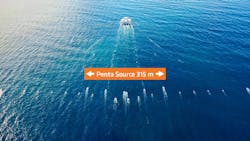PGS launches seismic survey in the Barents Sea
Offshore staff
OSLO, Norway – PGS’ Ramform Tethys has started a new project in the Barents Sea that uses what the company claims is the most advanced configuration ever towed by a seismic streamer vessel.
Last weekend, the Ramform Tethys reconfigured from a wide-tow triple source set-up to an even wider penta source solution (five arrays), with a total source separation of 315 m (1,033 ft). All source elements are placed in front of the streamers, with almost zero offsets. The 315-m source separation is the widest ever towed by a seismic vessel, the company claimed.
This project further extends its multi-client coverage in the Hammerfest basin.
It features:
- Wide-tow penta source with total source span of 315 m
- GeoStreamer: 16 streamers x 56.25 m (185.4 ft) nominal separation
- Includes three 10-km (6.2-mi) long streamer tails
- Deep tow at 25 m and 28 m (82 ft and 92 ft).
According to the company, wide-tow multi-source solutions can deliver high-quality images of shallow geological targets without sacrificing acquisition efficiency. PGS deployed a wide-towed triple-source on GeoStreamer X programs in the Viking Graben 2019 and 2020.
Wide-tow source until now has been in the 180 m to 250 m (591 ft to 820 ft) range (total source span). The imaging results and feedback from clients have been very good, the company said.
09/11/2020
